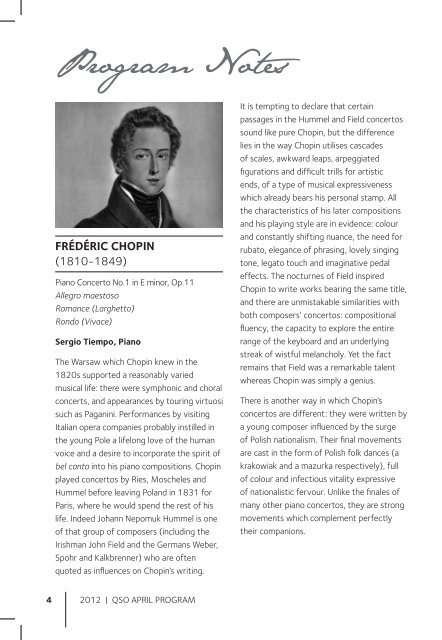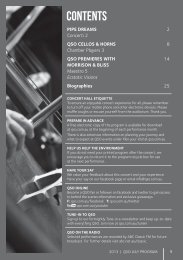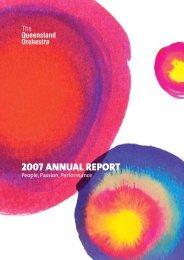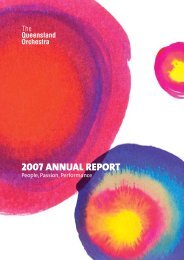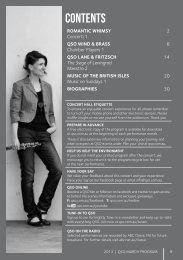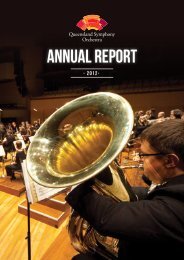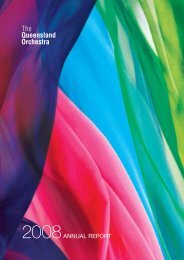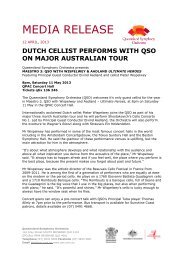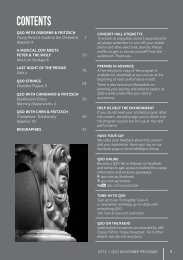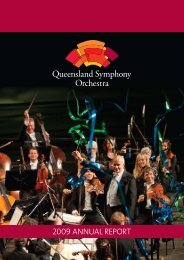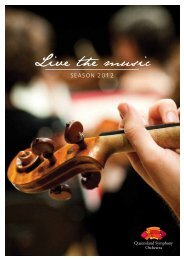April 2012 - Queensland Symphony Orchestra
April 2012 - Queensland Symphony Orchestra
April 2012 - Queensland Symphony Orchestra
Create successful ePaper yourself
Turn your PDF publications into a flip-book with our unique Google optimized e-Paper software.
Program Notes<br />
FRÉDÉRIC CHOPIN<br />
(1810-1849)<br />
Piano Concerto No.1 in E minor, Op.11<br />
Allegro maestoso<br />
Romance (Larghetto)<br />
Rondo (Vivace)<br />
Sergio Tiempo, Piano<br />
The Warsaw which Chopin knew in the<br />
1820s supported a reasonably varied<br />
musical life: there were symphonic and choral<br />
concerts, and appearances by touring virtuosi<br />
such as Paganini. Performances by visiting<br />
Italian opera companies probably instilled in<br />
the young Pole a lifelong love of the human<br />
voice and a desire to incorporate the spirit of<br />
bel canto into his piano compositions. Chopin<br />
played concertos by Ries, Moscheles and<br />
Hummel before leaving Poland in 1831 for<br />
Paris, where he would spend the rest of his<br />
life. Indeed Johann Nepomuk Hummel is one<br />
of that group of composers (including the<br />
Irishman John Field and the Germans Weber,<br />
Spohr and Kalkbrenner) who are often<br />
quoted as influences on Chopin’s writing.<br />
It is tempting to declare that certain<br />
passages in the Hummel and Field concertos<br />
sound like pure Chopin, but the difference<br />
lies in the way Chopin utilises cascades<br />
of scales, awkward leaps, arpeggiated<br />
figurations and difficult trills for artistic<br />
ends, of a type of musical expressiveness<br />
which already bears his personal stamp. All<br />
the characteristics of his later compositions<br />
and his playing style are in evidence: colour<br />
and constantly shifting nuance, the need for<br />
rubato, elegance of phrasing, lovely singing<br />
tone, legato touch and imaginative pedal<br />
effects. The nocturnes of Field inspired<br />
Chopin to write works bearing the same title,<br />
and there are unmistakable similarities with<br />
both composers’ concertos: compositional<br />
fluency, the capacity to explore the entire<br />
range of the keyboard and an underlying<br />
streak of wistful melancholy. Yet the fact<br />
remains that Field was a remarkable talent<br />
whereas Chopin was simply a genius.<br />
There is another way in which Chopin’s<br />
concertos are different: they were written by<br />
a young composer influenced by the surge<br />
of Polish nationalism. Their final movements<br />
are cast in the form of Polish folk dances (a<br />
krakowiak and a mazurka respectively), full<br />
of colour and infectious vitality expressive<br />
of nationalistic fervour. Unlike the finales of<br />
many other piano concertos, they are strong<br />
movements which complement perfectly<br />
their companions.<br />
It has been fashionable to deride Chopin’s<br />
orchestrations as colourless and inept. It<br />
must be admitted that Chopin limited the<br />
role of the orchestra as Liszt, Schumann and<br />
even Mendelssohn did not, letting it provide<br />
a sonorous backdrop for the solo part rather<br />
than engage in a genuine dialogue. However,<br />
Chopin always thought in pianistic terms and<br />
did not feel inclined to abandon his natural<br />
territory. Various attempts to reorchestrate<br />
the concertos (by Karl Klindworth and Karl<br />
Tausig) have generally not proved successful,<br />
and they are usually performed in their<br />
original form.<br />
Although the E minor concerto is known<br />
as the first and bears a lower opus number,<br />
it was actually written after the F minor but<br />
published first, hence the numbering with<br />
which we are familiar. The E minor dates from<br />
1830 and appeared in print three years later;<br />
the F minor was begun in 1829, completed<br />
the following year but not published until<br />
1836.<br />
David Bollard © 1998.<br />
LUDWIG VAN BEETHOVEN<br />
(1770-1827)<br />
<strong>Symphony</strong> No.6 in F, Op.68 Pastoral<br />
Awakening of happy feelings on arrival in the<br />
country (Allegro ma non troppo)<br />
Scene by the brook (Andante molto mosso)<br />
Peasants’ merrymaking (Allegro) –<br />
Thunderstorm (Allegro) –<br />
Shepherd’s song:<br />
Thanksgiving after the storm (Allegretto)<br />
When Beethoven sought tranquillity in the<br />
wooded environs of Heiligenstadt, outside<br />
Vienna, during the summer of 1802, his<br />
attention was drawn to a shepherd’s flute<br />
sounding in the fields but, the composer<br />
heard nothing. The realisation of the extent<br />
of his encroaching deafness was crushing.<br />
Months later he recalled the incident in the<br />
agony of his Heiligenstadt Testament. While<br />
Beethoven could face the prospect of being<br />
cut off from normal human communication,<br />
he was in despair at the thought of no longer<br />
hearing the voice of his best friend, Nature.<br />
In choosing to glorify Nature in his Sixth<br />
<strong>Symphony</strong>, Beethoven does no more nor<br />
less than give praise to God for all His<br />
works. There is no descent from the titanic<br />
4 <strong>2012</strong> | QSO APRIL PROGRAM <strong>2012</strong> | QSO APRIL PROGRAM 5


